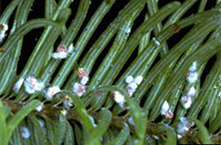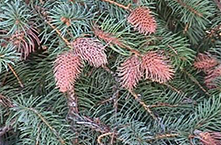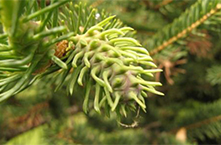Colorado Spruce, Engelmann Spruce, Sitka Spruce. Douglas Fir is an alternate host.
DAMAGE:
Feeding injury causes needles to twist and turn yellow and produces plump galls on the current year’s growth of Spruce trees only.
DESCRIPTION AND LIFECYCLE:
This insect can produce continuous generations on either Colorado Spruce or Douglas Fir but normally spends a portion of its two-year life cycle on each host. Overwintering females on spruce lay eggs near developing buds. Nymphs hatch as bud caps split. Nymphs feed at the base of developing buds in spring. Saliva introduced into the plant causes changes in plant development and produces cone-like galls on the tips of blue spruce branches. Galls open in mid-summer. Emerging adelgids either continue to live on spruce or fly to Douglas Fir to lay eggs. On Douglas Fir they may continue to live or produce a generation that flies back to spruce to produce the gall-forming stage. On Douglas Fir, feeding on needles by nymphs produces yellow spots and curled needles but not galls.
CONTROL MEASURES:
Control of Cooley Spruce Gall Adelgid is rarely needed to protect tree health. However, insects may be controlled to prevent aesthetic injuries that can detract from tree appearance. Infestations of this insect are highly cyclical, with their numbers often changing greatly from season to season. Treat in early spring before bud break or in early October. Thoroughly cover crevices in the bark of terminal twigs and the bases of buds. On Blue Spruce use only wettable powders to prevent foliage discolouration. If possible, remove and destroy galls in June.



REFERENCES: A Pocket IPM Scouting Guide for Woody Landscape Plants; By Diane Brown-Rytlewski Publication 383; Ministry of Agriculture, Food and Rural Affairs
